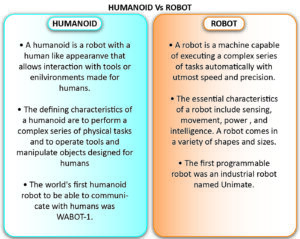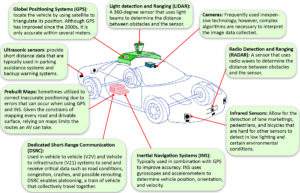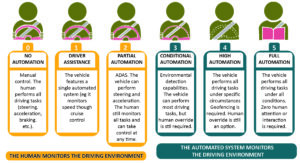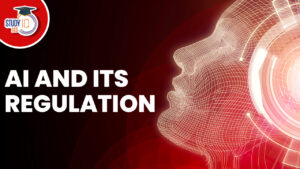Table of Contents
Introduction
Robotics is the field of engineering discipline concerned with the development, design, fabrication, and operation of robots. Its primary goal is to create intelligent machines that can assist humans in diverse tasks.
The field of robotics encompasses various manifestations. Robots can be humanoid (resembling humans) or they can be in the form of specialized applications like robotic process automation (RPA) to perform repetitive tasks governed by rules.
Although the exploration of robotics and its possibilities has experienced significant growth in the 20th century, the concept itself is not novel.
As part of both the Preliminary and the Mains Examination of the Union Public Service Commission – Civil Services Examination (UPSC-CSE), this chapter will give the basic as well as advanced understanding of the key recent developments in the field of robotics which have been asked several times in the examination.
Background
A robot is a machine or an autonomous system that can sense, process information, make decisions, and perform tasks or actions in the physical world. The credit for coining the term “robotics” in the 1940s is often attributed to science fiction writer Isaac Asimov, as recognized by the Oxford English Dictionary. In Asimov’s writings, he introduced a set of principles known as the Three Laws of Robotics to govern the behaviour of autonomous robots and intelligent machines.
Asimov’s Three Laws of Robotics:
- A robot must not harm a human being or, through inaction, allow a human being to come to harm.
- A robot must obey the orders given to it by human beings, except where such orders would conflict with the First Law.
- A robot must protect its own existence, as long as such protection does not conflict with the First or Second Laws.
However, it took a couple of decades, specifically in 1961, for the first programmable robot called ‘Unimate’ to be developed. Based on designs from the 1950s, Unimate was created to handle the task of moving scalding metal components from a die-casting machine.
Robots are typically composed of mechanical components, sensors, actuators, and a control system. The mechanical components provide physical structure and mobility, allowing robots to interact with their environment.
- Sensors inside a robot enable them to perceive and gather data about their surroundings, such as detecting objects, measuring distances, or capturing images.
- Actuators are responsible for the robot’s movement or manipulation, translating the control signals into physical actions.
- Control system encompasses the software and algorithms that govern the robot’s behavior, decision-making, and task execution.

Evolution of Robotics
The evolution of robotics has been a fascinating journey that has spanned several decades. From simple mechanical machines to sophisticated autonomous systems, robotics has made significant advancements in various fields and continues to shape our future. An overview of the key stages in the evolution of robotics are:
- Early Mechanical Robots: In the 1950s and 1960s, the concept of robotics emerged, and early mechanical robots were developed. One notable example is the Unimate, created by George Devol and Joseph Engelberger in 1961. Unimate was the first industrial robot used for tasks like handling and welding in a General Motors factory.
- Programmable Robots: In the 1970s and 1980s, the focus shifted to programmable robots capable of executing specific tasks. The Stanford Arm, developed in the late 1960s, was a programmable robotic arm used for assembly tasks in manufacturing.
- Industrial Automation: The 1980s and 1990s witnessed the widespread use of robots in industrial automation. One significant example is the PUMA (Programmable Universal Machine for Assembly), a robotic arm developed by Victor Scheinman in the 1970s. PUMA robots were widely used in manufacturing for assembly, welding, and material handling.
- Mobile Robots and Artificial Intelligence: Advancements in AI and mobile robotics led to the development of autonomous systems. The Mars rovers, including Sojourner, Spirit, Opportunity, and Curiosity, are prime examples of mobile robots. These rovers were sent by NASA to explore and collect data on the surface of Mars.
- Humanoid Robots: Humanoid robots, designed to resemble and interact with humans, gained attention in the early 2000s. ASIMO, developed by Honda, is a famous humanoid robot. It showcased advanced capabilities such as walking, running, climbing stairs, and interacting with people.
- Collaborative Robots (Cobots): Collaborative robots, or cobots, designed to work safely alongside humans, emerged in the 2010s. An example is the UR5, developed by Universal Robots. UR5 cobots are used in various industries for tasks like assembly, packaging, and quality control, working in close proximity to humans.
- Autonomous Systems and AI Integration: Present-day robotics focuses on the integration of AI and autonomous systems. Self-driving cars, such as those developed by Waymo and Tesla, are significant examples. These cars leverage AI, sensors, and computer vision to navigate and make intelligent decisions on the road.
Advancement in Robotics
- Artificial Intelligence and Machine Learning: Advancements in AI and machine learning have enabled robots to learn, adapt, and make intelligent decisions. An example is Boston Dynamics’ robot, Spot, which utilizes AI algorithms for dynamic navigation, obstacle avoidance, and terrain mapping.
- Sensing and Perception: Robotics has witnessed improvements in sensing and perception technologies. Robots like Roomba, developed by iRobot, utilize advanced sensors to navigate and clean floors autonomously, avoiding obstacles and adapting to different surfaces.
- Mobility and Manipulation: Robots have become more agile and versatile in terms of mobility and manipulation. For instance, the Baxter robot, created by Rethink Robotics, has dual arms that can perform various tasks alongside humans in industrial environments, with built-in safety features.
- Collaborative Robotics: The emergence of collaborative robots, or cobots, has revolutionized human-robot collaboration. The Universal Robots UR10 is an example of a cobot that can work side by side with humans, assisting in tasks like assembly, packaging, and quality control.
- Soft Robotics: Soft robots with flexible and deformable structures have gained attention. The OctopusGripper, developed by Festo, mimics the movements of an octopus and is capable of handling delicate objects with precision.
- Swarm Robotics: Swarm robotics involves coordinating large numbers of simple robots to perform tasks collectively. The Kilobots, developed by Harvard University, are small robots that communicate and collaborate to achieve complex objectives, such as self-assembly or exploration.
- Medical Robotics: Robotics has made significant contributions to healthcare. The da Vinci Surgical System, developed by Intuitive Surgical, allows surgeons to perform minimally invasive procedures with enhanced precision and dexterity.
- Autonomous Systems: Autonomous systems, such as self-driving cars, have made significant strides. Waymo, a subsidiary of Alphabet Inc., has developed self-driving cars that leverage AI, sensors, and mapping technologies to navigate safely and make real-time decisions on the road.
- Humanoid Robots: Humanoid robots aim to mimic human appearance and behavior. Sophia, developed by Hanson Robotics, is a humanoid robot capable of engaging in conversations, displaying emotions, and recognizing faces.
- Exoskeletons: Exoskeleton robots assist humans in enhancing strength and mobility. The EksoGT, developed by Ekso Bionics, is an exoskeleton that enables individuals with lower limb impairments to regain the ability to walk.
Advantages and Disadvantages of Robotics
Advantages of Robotics:
- Enhances Efficiency and Productivity: Robots can perform tasks faster, more accurately, and consistently compared to humans, leading to increased efficiency and productivity in industries such as manufacturing, logistics, and agriculture. They can work around the clock without fatigue or breaks, enabling continuous operation.
- Medical Advancements: Surgical robots, like the da Vinci Surgical System, enable surgeons to perform minimally invasive procedures with enhanced precision, reducing patient trauma, pain, and recovery time. Similarly, robotic prosthetics provide individuals with improved mobility and functionality.
- Environmental Benefits: Robots can be employed in tasks aimed at environmental conservation, such as automated waste sorting, land and ocean cleanup, and precision agriculture. They contribute to resource efficiency, reduce pollution, and aid in sustainable practices.
- Exploration and Disaster Response: Robots play a crucial role in exploration and disaster response. For instance, drones equipped with sensors are employed for search and rescue missions, surveying disaster-stricken areas, and delivering supplies to remote or hazardous locations.
- Assistance and Support: Robots can assist humans in various ways, such as performing repetitive or physically demanding tasks, aiding in healthcare procedures, or providing support for individuals with disabilities. They can improve the quality of life and enhance human capabilities.
- Exploration and Research: Robots have been instrumental in space exploration, deep-sea exploration, and other challenging environments, where humans cannot easily reach. They gather valuable data, conduct research, and expand our understanding of the universe and unexplored territories.
Disadvantages of Robotics:
- Ethical Considerations in Autonomous Systems: The increasing autonomy of robots raises ethical concerns. Autonomous weapons, for example, can lead to significant human rights and security issues if misused. Ensuring responsible use and establishing legal frameworks are critical to address these challenges.
- Job Displacement and Skills Gap: Widespread implementation of robotics in industries may lead to job displacement, particularly in routine and repetitive tasks. Workers will need to adapt to new roles, requiring upskilling and training to bridge the skills gap created by automation.
- Social Impact and Human Interaction: Overreliance on robots in certain contexts, such as eldercare or education, may hinder meaningful human interactions and emotional connections. Maintaining a balance between the human touch and technological assistance is crucial to preserve social dynamics.
- Privacy and Data Security: As robots become more integrated into our lives, concerns about privacy and data security arise. Robots equipped with cameras and sensors can capture sensitive information, necessitating strict regulations to protect individuals’ privacy and prevent data breaches.
- Socioeconomic Inequality: The widespread adoption of robotics technology may exacerbate socioeconomic inequality. While large corporations can afford advanced robotic systems, small businesses and marginalized communities may face challenges in accessing and benefiting from these technologies, leading to potential disparities.
- Initial Costs and Maintenance: The initial investment in robotics technology can be substantial, including the cost of purchasing, programming, and integrating robots into existing systems. Maintenance and repairs also require specialized expertise, adding to the long-term costs.
Robotics in India
Development of Robotics in India
1960s-1970s:
- The Indian Space Research Organisation (ISRO) played a pivotal role in the early years of robotics in India. In the 1960s, ISRO developed the first industrial robot in India called “Mohandas,” which was used for welding rocket components.
- The Central Mechanical Engineering Research Institute (CMERI) in Durgapur, West Bengal, began research on robotics during this period. CMERI developed robots for various applications such as welding, inspection, and handling.
1980s-1990s:
- In the 1980s, the Department of Electronics (DoE) established the Center for Artificial Intelligence and Robotics (CAIR) in Bangalore. CAIR focused on research and development in robotics and automation, contributing significantly to the field’s growth in India.
- Indian educational institutions, such as the Indian Institute of Technology (IIT) in Bombay and the Indian Statistical Institute (ISI) in Kolkata, started conducting research in robotics, particularly in areas like machine learning and computer vision.
2000s-Present:
- The emergence of robotics startups in the early 2000s marked a significant milestone in the development of robotics in India. Companies like GreyOrange, Asimov Robotics, and Systemantics gained recognition for their innovative robotic solutions.
- In recent years, the Indian government has placed increased emphasis on robotics and automation. Initiatives like the Make in India campaign and the National Policy on Electronics have aimed to promote domestic manufacturing, including robotics.
Achievements of Robotics in India
The Indian Economic Survey 2017-18 recognized robotics as a key focus area, highlighting its importance alongside blockchain, AI, and other futuristic technologies. The ‘Make in India 2.0’ initiative was expected to give special attention to robotics.
- In collaboration with the Kerala government, Genrobotics, a startup based in Thiruvananthapuram, introduced “Bandicoot,” a spider-shaped robot designed for cleaning sewers and manholes in the city.
- GreyOrange, founded by a group of Indian technologists in 2011, has emerged as India’s leading robotics technology company. They have significantly transformed supply chain automation processes.
- India has witnessed a rise in robotics competitions and events such as the Indian Robotics Olympiad and Techfest, that nurture student interest and provide platforms to showcase talent.
- The healthcare sector in India has also embraced robotics, particularly for precision operations. For instance, Ahmedabad-based Apex Hospital utilized Corpath technology from Corindus Vascular Robotics, a US-based company, to remotely control a robot for a telerobotic heart surgery on a patient located 32km away in Gandhinagar in December 2018.
- Manav, India’s first 3D-printed humanoid robot, incorporates vision and sound processing capabilities. It is primarily intended for research purposes and is made available to research institutes offering robotics as a subject of study.
- Mitra, India’s first indigenously built humanoid robot, was launched by Prime Minister Narendra Modi and Ivanka Trump at the Global Entrepreneurship Summit (GES) conference in 2018. It can be found interacting with customers in the corridors of Canara Bank and PVR Cinemas in Bengaluru.
- Robocop, deployed in Hyderabad, is a police robot designed to assist in law enforcement, traffic management, and security. It can autonomously secure and protect various public spaces, including offices, malls, airports, and signal posts, and is capable of bomb disposal.
- KEMPA is a special robot assistant created to cater to the needs of Kempegowda International Airport. It responds to queries from confused passengers in both English and Kannada.
- RADA, developed by Vistara, a joint venture between Tata Sons and Singapore Airlines, is an artificial intelligence-based robot designed to automate simple tasks and enhance customer experience.
- IRA (Intelligent Robotic Assistant) is a shiny white interactive humanoid robot that aids bank branch staff in servicing customers. It was launched in Mumbai in 2018.
- INDRO, reportedly the tallest humanoid robot built in India, is an autonomous robot constructed using easily available, low-cost materials such as aluminium, wood, cardboard, and plastic. It can perform lightweight tasks, including entertainment, education, and some household chores.
- DRDO’s Daksh, introduced in 2011 and currently employed by the Indian Army, is a domestically developed robot primarily used for detecting and neutralizing Improvised Explosive Devices (IEDs). Equipped with X-ray vision, Daksh can identify hazardous objects and defuse them using a jet of water. In 2015, it received upgrades with chemical, biological, radiological, and nuclear hazard detection capabilities.
Challenges related to robotics
- Insufficient Hardware Ecosystem: The absence of a robust hardware ecosystem leads to a heavy reliance on imports for most robot components. This creates hurdles due to challenges in obtaining dual-use certifications, high import duties, and navigating complex permission-driven environments.
- Financial Incentives: The current tax structure in India imposes a significant burden on companies importing robots, with an approximate tax rate of 26.85% (comprising 7.5% Basic Customs duty plus 18% GST). This taxation policy acts as a deterrent to the widespread adoption of robots, hindering their mass utilization. As a result, the density of robots in India is one of the lowest, 4 per 10,000 employees, among developing and developed countries.
- Shortage of Skilled Human Resources: The FICCI-TSMG Advanced Manufacturing Survey 2016 highlighted the scarcity of quality human resources equipped with the necessary skills and expertise to work with advanced manufacturing technologies. This scarcity negatively affects India’s ability to engage in cutting-edge R&D in the field of robotics.
- Mindset Shift Requirement: The robotics industry faces political obstacles despite the government’s recent focus on robotics. There exists a misconception that robots will lead to job losses in an already precarious job market. However, this perception overlooks the potential for robots to complement human workers and enhance productivity rather than replace them.
- Low academic interest: Despite the exciting prospects offered by the field of robotics, it is observed that only a small percentage of students, around 8-10%, are inclined to pursue a career in this domain. One of the primary reasons behind this is the perception that entering the field of robotics may not immediately provide lucrative financial rewards in the first year after graduation.
Future of Robotics in India
The Indian government is playing a significant role in promoting the widespread adoption and popularity of robotics in the country.
- As part of this effort, the Principal Scientific Adviser and the Government of India, under the Prime Minister’s Science, Technology and Innovation Advisory Council (PM-STIAC), have signed nine missions. These missions aim to drive advancements in robotics and related technologies, fostering innovation and development.
- The All India Council for Robotics and Automation (AICRA) has recently introduced a new program called the ‘Tech Startup Program.‘ This initiative is designed to serve as an incubation platform for startups and early-stage adopters who are engaged in the field of Robotics and Robotics Process Automation (RPA) within India. The program aims to provide a supportive environment for these emerging ventures, offering guidance, resources, and opportunities to accelerate their growth and success in the robotics and automation industry.
- Furthermore, NITI Aayog, the government’s policy think tank, has signed a statement of intent with ABB India to leverage the benefits of robotics and artificial intelligence (AI). This partnership signifies the government’s commitment to harnessing the potential of robotics in various sectors.
- In line with these initiatives, NITI Aayog has also begun working on recommendations for government ministries regarding guidelines and policies for the development and adoption of AI. These guidelines will facilitate the integration of industrial automation and digitalization, serving as a foundation for the growth of robotics and AI across sectors. Consequently, we can anticipate the presence of robots in government operations in the near future.
Humanoid Robots in India
Introduction
|
Anthropomorphism |
| It is defined as the tendency to attribute human forms, emotions and behaviors to non-human animals or objects. |
Humanoid Robots have an anthropomorphic body and they can move within an environment designed for human. It resembles the human body in shape. In general, humanoid robots have a torso, a head, two arms and two legs though some may replicate only part of the body, for example, from the waist up.
Some of the Humanoid Robots in India are:
- AcYut: It is India’s first ever indigenously designed autonomous humanoid developed at the Centre for Robotics and Intelligent Systems, BITS Pilani. It is equipped with a RGB Camera for vision and Inertial Measurement Unit for spatial orientation as provided by the Vestibular apparatus in human body.
- Manav: It is India’s first three- dimensional printed humanoid robot. It has in-built vision and sound processing capability. It has Wi-Fi and Bluetooth connectivity and also has a rechargeable lithium polymer battery. Primarily, it will be used for research purposes in premier institutions like IITs, NITs etc.
- IRA: Interactive Robot Assistant (IRA) has been launched by HDFC for customer services. It is a GPS enabled indoor humanoid which has a speech recognition module to understand what customers speak. It has ultrasonic sensor to move inside the branch and will have a face recognition algorithm for recognition of the customers.
- Mitra: It is programmed to greet customers and interact using facial and speech recognition, contextual help and autonomous navigation. It is fully manufactured and assembled by Bengaluru based firm Invento Robotics.
- RADA: It is Artificial Intelligence based Humanoid Robot that will be placed at Indira Gandhi International Airport Delhi. It will answer customer’s queries, provide entertainment options and take customer feedback. It will scan boarding passes and provide details of the terminal, departure gates, and weather conditions of the destination city.
- KP-BOT: Kerala has launched this Robocop at Kerala Police Headquarters in the state capital. It was made by state police cyber dome and a Kochi based start-up Asimov. It has been assigned duties like meeting and greeting officers and visitors through facial recognition and it will also guide visitors to the appropriate areas within the office.
- Kempa: It is placed at Kempegowda airport in Bengaluru to give directions to the passengers, providing information, scanning luggage and handing out boarding passes. It will also share information about Karnataka, its culture and heritage and places to visit from the tourist point of view.
- Vyommitra: This is designed and developed by the Indian Space Research Organization to fly aboard unmanned test missions ahead of the Gaganyaan human space-flight mission. It is a half-humanoid lacking lower limbs. It is designed to fly aboard a rocket, withstanding vibrations and shock during the flight. It has been designed to resemble a human with facial expressions and speech and sight capabilities.

High Performance Computing System
High Performance Computing refers to the practice of aggregating computing power in a way that delivers much higher performance than one could get out of a typical desktop computer or workstation in order to solve large problems in science, engineering, or business. It plays important role in both scientific advancement and economic competitiveness of a nation- making production of scientific and industrial solutions faster, less expensive, and of higher quality. AIRAWAT, PARAM Porul, PARAM SIDDHI-AI, Pratyush and Mihir are some of the supercomputers in India.
Applications of High Performance Computing
- Healthcare, genomics and life sciences: It is very helpful in sequencing a human genome, drug discovery and design, rapid cancer diagnosis and molecular modelling.
- Financial Services: It is helpful in automated trading, fraud detection, risk analysis methods and in the emerging online currency world such as bitcoin. Supercomputers will be helpful in extracting data from the cloud system.
- Government and defense: weather forecasting and climate modelling are done with the processing of vast amount of historical meteorological data and millions of daily changes in climate-related data points. It is also employed for energy research and intelligence work. For defense purposes, it provides virtual testing for nuclear explosion and weapon ballistics.
- Energy: It includes seismic data processing, reservoir simulation and modelling, geospatial analytics, wind simulation and terrain mapping.
Challenges of High Performance Computing
- India currently lacks the infrastructure to produce the semiconductor devices which are required for the development of supercomputers.
- Only 4 supercomputers of India showcased in World’s TOP500 List of Supercomputers (AIRAWAT-75, PARAM SIDDHI- 131, Pratyush-169, Mihir-316) whereas China and USA topped the list in TOP 500 Supercomputers.
- India lacks highly skilled workforce for the development of supercomputers. In India, the use of supercomputers is limited to research institutions only due to lack of awareness.
- We do not have any exascale supercomputers which can do billions of computations per second.
- There is crunch of funds for research as only Rs 7,931 crore has been allocated for Department of Science and Technology in Union Budget 2023-24
Way Ahead
- India is fast emerging a leader in high power computing with the National Supercomputing Mission boosting it to meet the increasing computational demands of academia, researchers, MSMEs, and startups in areas like oil exploration, flood prediction as well as genomics and drug delivery.
- India is scaling up its supercomputing prowess and will install an 18-petaflop system in 2023 which will ease the complex mathematical calculations for weather forecasting.
- With Supercomputer AIRAWAT reaching 75th position in TOP500 Supercomputers List, India is looking to develop indigenous exascale computing capabilities through National Supercomputing Mission.
- India has started building the hardware required for supercomputers. India’s network of research institutions, in collaboration with industry, is scaling up the technology and manufacturing capability to make more and more parts in India.
Pratyush and Mihir
About-
- Pratyush and Mihir are the two supercomputers that were installed in 2018 by the Ministry of Earth Sciences.
- Pratyush is India’s fastest supercomputer with 3.7 petaflops high performance. The supercomputer is placed at the Indian Institute of Meteorology, Pune. It can deliver a maximum power of 6.8 petaflops.
- Mihir is placed at the National Centre for Medium Range Weather Forecast in Noida. It has a capacity of around 2.5 petaflops.
- Pratyush and Mihir consists of several computers that can deliver a peak power of 6.8 PetaFlops.It is the first multiPetaFlops supercomputer ever built in India.
Use
- It helps the country to make better forecasts in terms of Monsoon, fishing, air quality, extreme events like Tsunami, cyclones, earthquakes, lightning and other natural calamities such as floods, droughts etc. India is the fourth country in the world to have a High Performance Computing facility/ Supercomputer dedicated for weather and climate research after Japan, the United States and the United Kingdom.
Automated vehicles
Most of the vehicles today have driver assistance technologies, which help towards building road safety. While some driver assistance technologies are designed to only warn you if you’re at risk of an accident, others are designed to take action to avoid an impending accident.
This continuing evolution of automoted technologies, including driver assistance technologies and automated driving systems, aim to address the safety needs and better road experience.
About
An automated vehicle or a self-driving vehicle car, is a vehicle that is capable of traveling even without human assistance . These vehicles use sensors like cameras, Lidar, ultrasound, GPS, thermal sensors etc. Based on the technology and Artificial intelligence, the car then identifies the most appropriate navigation path and traffic controls strategies.
The technology is at a very nascent stage. Once it reaches maturity, autonomous vehicles are envisioned to have a spill over effect on the automotive industry, health, welfare, urban planning, traffic and the overall economy.
Working
Automated vehicles create an internal map of their surroundings, based on the inputs from the sensors and AI.
Software then processes those inputs, creates a path, and sends final output to control the acceleration, braking, and steering and other mobility work.
Hard-coded rules, obstacle avoidance algorithms, predictive modelling, and “smart” object discrimination (i.e., knowing the difference between a bicycle and a motorcycle) help the software follow traffic rules and navigate obstacles.
The other technology uses Lidar, a remote sensing method that uses light in the form of a laser to measure distances and range, alongwith the traditional sensors. Although it needs more data-processing, but it is more robust and sustainable in traffic-heavy environments.

Advantages
SAFETY
Automated vehicles could help in improving safety and reducing the accident count, as software generally are known to be less error-prone than humans, but cyber crime is an imminent threat .
ECONOMIC AND SOCIETAL BENEFITS
Automated vehicles could deliver additional economic and societal benefits. One of them is that the Self-driven vehicles could help in transportation of individuals who are unable to drive themselves, such as the elderly and disabled.
ENVIRONMENTAL
Vehicle automation is going to be helpful in land use management. With increased use of self driven vehicles, the parking space needs are going to be potentially reduced. Also, vehicle electrification would possibly improve efficiency with less personal driving, resulting in further reductions of emissions from the transport sector.
EFFICIENCY AND CONVENIENCE
This would help in better urban traffic management and reduce the number of hours spent in traffic delays, which in turn would help in decreasing fuel costs and vehicle emissions. Automated driving systems have the potential to improve overall efficiency and convenience of road transport.
Levels of Automated Vehicles

There are six different levels of automation. As the levels increase, the independence regarding operation control increases.
- At level 0—No Automation-the car has no control over its operation and its the human driver that does all of the driving.
- At level 1-Driver Assistance- the vehicle’s ADAS (advanced driver assistance system) has the ability to support the driver with various functions like braking, steering etc.
- At level 2- Partial Automation- the ADAS can oversee steering and accelerating and braking in some conditions, although the human driver is required to continue paying complete attention to the driving environment throughout the journey and he/she performs the remaining tasks.
- At level 3 – Conditional Automation-the ADS (advanced driving system) can perform all parts of the driving task in some conditions, but the human driver has to regain control whenever requested by the ADS.
- At level 4- High Automation- the vehicle’s ADS is able to perform all driving tasks independently in certain conditions in which human attention is not required.
- At level 5- Full Automation- in this, the vehicle’s ADS is able to perform all tasks in all conditions. The assistance is from the human driver is not required. This full automation would require the application of 5G or higher technology, which will allow vehicles to communicate not just with one another, but also with traffic lights, signage and even the roads themselves. This would change the whole traffic system.
Concerns
- Rise in unemployment-The adoption of self driven vehicles would eliminate the need of drivers and thus have an adverse impact on employment.
- Not in sink with the existing infrastructure- In developing countries where there are unplanned infrastructure and haphazard development and weak implementation of traffic rules, the sustainability of automated vehicles is questionable.
- Error in technology- Recent crash involving an Uber driverless car in Arizona, fatal Tesla accidents in 2018. These instances raises the issue of the feasibility of automated vehicles.
- High initial cost- At nascent stage, the initial cost maybe too exponentially high that it would not be an option of transport in the short term. However, as the technology mature, it would bring significant societal savings.
Notes and References
- https://pib.gov.in/PressReleasePage.aspx?PRID=1926942
https://en.wikipedia.org/wiki/Humanoid_robot
- https://www.meity.gov.in/content/high-performance-computinghpc
- https://www.cdac.in/index.aspx?id=hgc
https://journalsofindia.com/robotics-in-india/
https://www.bisinfotech.com/the-future-of-robotics-in-india/

 Daily Quiz 18 April 2025
Daily Quiz 18 April 2025
 OSSC CGL Syllabus 2025 and Exam Pattern ...
OSSC CGL Syllabus 2025 and Exam Pattern ...
 AI and its Regulation in India, Limitati...
AI and its Regulation in India, Limitati...





















